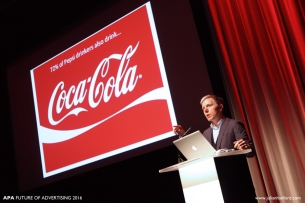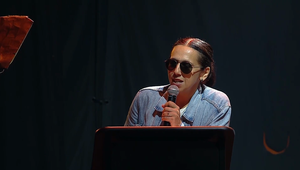
Stop Worrying About the Future and Focus on Good Creative Ideas

There’s a lot to worry about if you let yourself. Digital innovation is overwhelming if you try to keep up with the cutting edge, and threats like adblocking may seem apocalyptic, but they must never get in the way of creativity. Advertising will survive if it sticks to what has always worked: the right idea, beautifully crafted.
Advertising is an industry of futurephiles. We’re always worrying about the next apps, technologies and trends. The amount of thought-leadership events, workshops and column inches dedicated to staying ‘ahead of the curve’ is terrifying. But it hasn’t always been this way.
The Future of Advertising… In One Afternoon is one attempt to filter through the vast sea of industry prophesising. Organised by the Advertising Producers Association, it’s an annual conference condensing the most interesting advertising thought into just a few hours. I attended earlier this week.
Journalist Ian Leslie, the first speaker of the day, expanded on his Financial Times article, ‘How The Mad Men Lost The Plot’, recounting the history of how people in advertising gradually got lost down the rabbit hole of digital technologies and everything they promised, forgetting the power of good creative ideas while they were distracted.
Running through various studies of advertising effectiveness, he suggested that some of the most powerful techniques are repetition (keeping a brand familiar), emotion (associating a brand with feelings) and passivity (not demanding effort from people who, frankly, don’t care about brands). Oddly enough, nothing in the digital quagmire can achieve all these at once. “If you took all those things and said you’re going to design an app for that, you would probably come up with TV,” he concluded. “By accident or design, TV is an incredibly effective way to do all these things.”
Leslie’s outsider analysis turned out to be a thread that could be traced through the whole event: a reassurance that the ground won’t crumble beneath you if you neglect to shoehorn Snapchat into that bog roll campaign. Your client will be happy if you provide them with the right creative solution, using whatever tools are appropriate, old or new.
Dan Wilks from the Advertising Association thinktank Credos explained why we need to be having this debate. Recent research revealed only 34% of people would recommend a career in advertising to friends or family – an even lower figure than bankers gave. Advertising is held in lower regard by the public than ever.
Despite hailing from another industry fixated on tech, Tom Rainsford and Abi Pearl from GiffGaff emphasised that as clients who have built a successful brand, their key to success has been collaborating with the right creative minds, listening to creative teams and directors and allowing them to pursue their vision. In a world dominated by procurement and hierarchical structures, it’s becoming ever rarer to hear a brand so trusting of people’s creative talents.
While the contrarians promoted the eternal value of talent and creativity, an event with the word ‘future’ in its title needs its fair share of tech-porn. The middle acts demonstrated the array of tools now available to advertisers, with Dan Philips of MPC running through the opportunities of interactive advertising, real-time animation and of course virtual reality, which is ubiquitous these days.
While it’s easy to get lost in the flashy gadgetry, Evan Boehm of Nexus Interactive Arts delved into how profound the storytelling potential of these technologies could be, speaking about developments even post-VR and how utterly immersing people in a space will change the craft of narrative. He stressed that when interactive experiences are made with good ideas, people take the time to spend time with them and even invite their friends to share these digital spaces with them.
With the emotional force of TV already established, Felix Morgan of Brave took the stage to tell us what we can prove using biometrics – the focus group that doesn’t lie. Armed with the tools he demonstrated, agencies can prove what their stories make people feel and even break down the specific emotions that a piece of advertising provokes.
BBH Managing Director Mel Exon tied all of this together with a very zeitgeisty presentation – AdBlocking: Advertising Apocalypse? The proliferation of adblockers is one of the many worries that the industry has found itself wracked by, but these apps don’t exist to wipe advertising off the face of the earth. They’re a response to the sort of advertising no self-respecting creative would want to make; the intrusive, irrelevant and often plain ugly banner ads and popups that previously plagued us. In fact, many of the major adblockers are moving towards a model that allows good advertising through.
Her answer was simple: “Put the user experience first. We can genuinely help by making better work.” That might include CGI, code or VR, but these are just tools. The key is to make stuff that people like.
Alex Reeves is Co-Editor of The Beak Street Bugle













